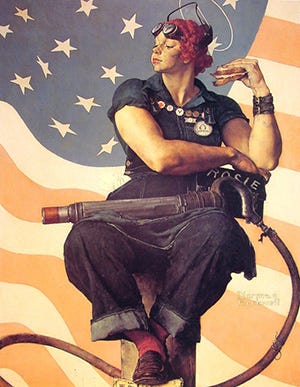Rosie the Riveter
She's not who you think.
Sources:
There’s some conflicting information on this song. Some places say it’s from 1943 (which would make it concurrent with the Westinghouse Electric poster), but some say it’s from 1942 (which would predate the iconic Westinghouse poster). The disparity appears to come from when the lyrics were written by Redd Evans and John Jacob Loeb and when it was first recorded as a song. The music and lyrics appear to be written in 1942, while the musical versions of it by people like Kay Kyser or The Vagabonds (their version in the video above) were in 1943.
The song is said to have been inspired by Rosalind Walter, a riveter at the Corsair Plant.
The Westinghouse Electric poster never actually called the woman “Rosie the Riveter” in point of fact. Nothing with the name “Rosie” is on the poster.
However, Norman Rockwell’s version DOES feature the name Rosie AND a riveting machine.
Norman Rockwell’s Rosie the Riveter received mass distribution on the cover of the Saturday Evening Post on Memorial Day, May 29, 1943. Rockwell’s illustration features a brawny woman taking her lunch break with a rivet gun on her lap, beneath her a copy of Hitler’s manifesto, Mein Kampf and a lunch pail labled “Rosie”. Rockwell based the pose to match Michelangelo’s Sistine Chapel ceiling painting of the prophet Isaiah.
Rockwell’s model was a Vermont resident, then 19-year-old Mary Doyle Keefe who was a telephone operator near where Rockwell lived, not a riveter. Rockwell painted his “Rosie” as a larger woman than his model, and he later phoned to apologize. The Post’s cover image proved hugely popular, and the magazine loaned it to the U.S. Treasury Department for the duration of the war, for use in war bond drives.
As pointed out by a comment from a mutual on the TikTok at the top of this page, the reason the Westinghouse Electric portrait became so iconic was one simple reason…copyright law. Norman Rockwell’s version was copyrighted and the We Can Do It version was not, making it the obvious choice in the 1980s when the women’s movement was using Rosie for posters.
I’ll be delving more into the history of this history and the history of women’s World War 2 era work in manufacturing in a future episode of Bitchy History.






